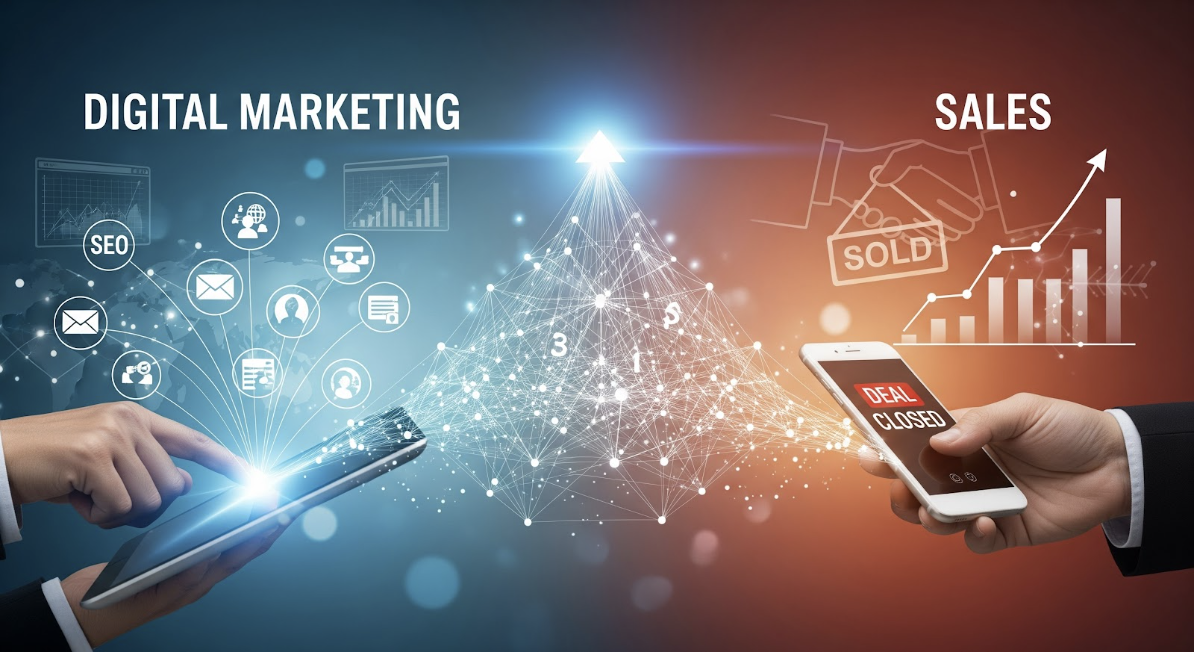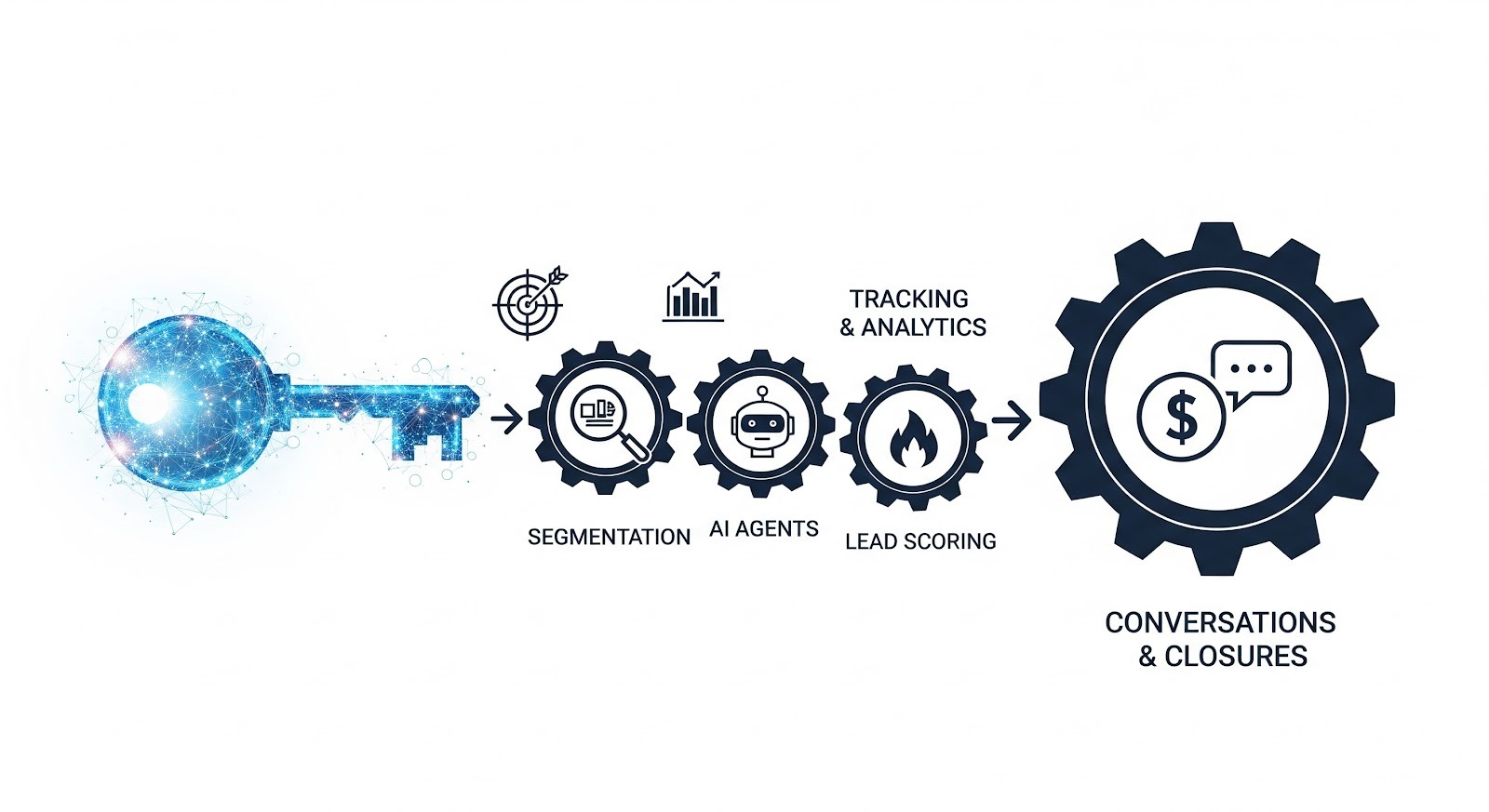Digital Marketing & Sales: The perfect combination for B2B growth 2025

In today's B2B landscape, the traditional silos between marketing and sales have become obsolete. While digital marketing generates attention and builds awareness, sales transforms that interest into measurable revenue—but the magic happens when these functions operate as a unified force. The most successful companies in 2025 have recognized this reality, seamlessly aligning both worlds along one continuous, strategic pathway that consistently expands their revenue engine.
What is integrated digital marketing & sales?
Integrated marketing and sales strategies create a seamless bridge between digital marketing initiatives and direct sales activities. Rather than functioning as isolated departments, both teams work together as one unified revenue engine for maximum growth.
Marketing opens the conversation – Sales closes the deal
The era of siloed departments is over. Modern B2B companies understand that marketing creates meaningful engagement with prospects, while seales transforms that engagement into revenue-generating partnership.
The customer journey in the digital age
Digital marketing creates visibility, reach, and the right storytelling throughout the customer journey. It builds the initial connection with potential customers and sparks their interest through:
- Content Marketing for every stage of the buying process
- Targeted Messages based on buyer personas
- Multi-Channel Presence across all relevant platforms
Sales takes over where genuine interest and concrete needs arise — and drives the conversation consistently toward closing the deal. The key difference: while marketing sets the stage, sales turns interest into measurable results.
The key: Qualified opportunities instead of just leads
The magic happens when marketing doesn’t just generate leads, but delivers qualified opportunities that sales can immediately act on. This seamless handoff eliminates friction and shortens sales cycles by an average of 25–40%.
Data is gold – for both sides
In the data-driven business world of 2025, analytics is the key to success. Precise customer segmentation ensures that campaigns reach the right buyer personas without wasting resources.
How data analytics connects sales and marketing:
- Tracking & analytics provide sales with the insights needed to ask relevant questions and present key arguments in the first conversation.
- AI agents and marketing automation streamline workflows, ensuring no time is wasted on manual tasks.
- Lead scoring enables sales to focus on the most promissing opportunities.
- Behavioral Tracking shows which content engages prospects the most.
The result: Sales can focus where it matters most—on conversations and closing deals, not on administrative tasks.

Emotional storytelling meets straight-line closing
People don’t make purchasing decisions purely rationally. B2B customers buy not just with logic, but with emotion. Marketing sparks enthusiasm through content that conveys vision and tangible benefits.
Sales amplifies this excitement with the right tone, rapport-building, and targeted questions. Crucially, sales guides the customer back onto the “straight line” whenever doubts or objections arise.
3 Successful real-world examples of marketing-sales integration
1. Drive-to-Store campaigns
Digital targeting drives customers to the store—while the in-person salesperson closes the deal. The online campaign creates the motivation; personal contact seals the deal.
2. Cross-Channel marketing
Consistent messaging across all channels builds trust and recognition. Whether on LinkedIn, the website, or email, customers encounter the same professional presence everywhere.
3. AI-Sales-Agents
Marketing automates lead scoring and nurturing processes, while sales focuses on the most qualified opportunities. Artificial intelligence handles the groundwork, and human expertise closes the deal.
One revenue engine – The key to sustainable success
Companies that treat marketing and sales as one integrated machine, rather than two separate departments, achieve long-term success. Marketing builds momentum, creates awareness, and generates qualified leads. Sales sustains that momentum, guides it strategically, and closes deals consistently.
The results speak for themselves: less friction, more revenue, and greater scalability.
Companies that fail to synchronize marketing and sales today miss valuable opportunities and waste resources. Those who get it right build an unstoppable revenue engine that grows continuously and predictably.
Let’s analyze your marketing-sales alignment and provide concrete steps for sustainable growth. Together, we’ll build an integrated system that transforms your business potential into measurable results.
Download our trendbook

Our TrendBook, born from the fusion of our agency’s expertise, unveils four key trends shaping the media and advertising industry, carefully analyzed by our experts:
- How to capture consumers in the age of the Messy Funnel
- Why AI is emerging as a cultural revolution
- How television is evolving into a multifaceted medium
- Why influencer marketing has reached the age of maturity




